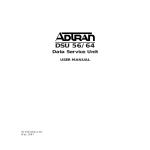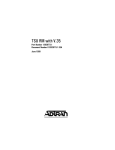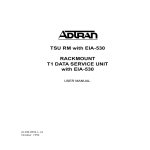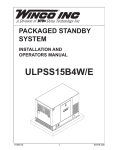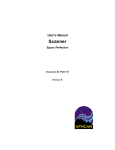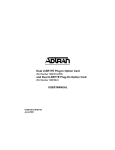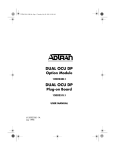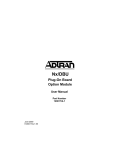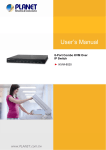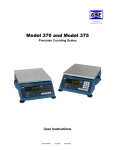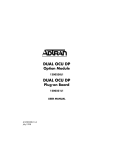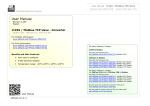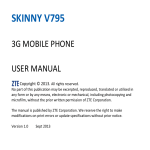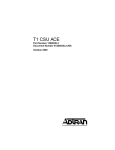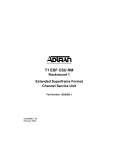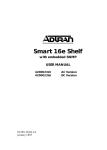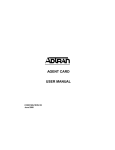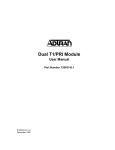Download TSU RM with V.35 - Optimum Data Inc.
Transcript
TSU RM with V.35 RACKMOUNT T1 DATA SERVICE UNIT with V.35 USER MANUAL 61200.077L1-1B June 1997 901 Explorer Boulevard P.O. Box 140000 Huntsville, AL 35814-4000 Phone: (205) 963-8000 © 1997 ADTRAN, Inc. All rights reserved. Printed in the USA. FCC regulations require that the following information be provided to the customer in this manual. 1. This equipment complies with Part 68 of the FCC rules. On the rear of the faceplate is a label that contains, among other information, the FCC registration number for this equipment. If requested, provide this information to your telephone company. 2. If your telephone equipment (TSU) causes harm to the telephone network, the Telephone Company may discontinue your service temporarily. If possible, they will notify you in advance. But if advance notice isn’t practical, you will be notified as soon as possible. You will be advised of your right to file a complaint with the FCC. 3. Your telephone company may make changes in its facilities, equipment, operations, or procedures that could affect the proper operation of your equipment. If they do, you will be given advance notice so as to give you an opportunity to maintain uninterrupted service. 4. If you experience trouble with this equipment (TSU), please contact ADTRAN (see Customer Service and Warranty Information in the inside back cover of this manual) for repair/ warranty information. The telephone company may ask you to disconnect this equipment from the network until the problem has been corrected, or until you are sure the equipment is not malfunctioning. 5. This unit contains no user serviceable parts. 6. An FCC compliant telephone cord and modular plug is provide withthis equipment. This equipment is designed to be connected to the telephone network or premises wiring using a compatible modular jack which is Part 68 compliant. See Installation Instructions for details. 7. The following information may be required when applying to your local telephone company for leased line facilities. Service Type Digital FacilityService Order Interface Code Code 1.544 Mbps Digital Interface SF 04DU9-B 1.544 Mbps Digital Interface ESF 04DU9-C 1.544 Mbps Digital Interface ESF with B8ZS 04DU9-C 6.0F 6.0F 6.0F Network Jacks RJ48C RJ48C RJ48C FEDERAL COMMUNICATIONS COMMISSION RADIO FREQUENCY INTERFERENCE STATEMENT: This equipment has been tested and found to comply with the limits for a Class A digital device, Pursuant to Part 15 of the FCC Rules. These limits are designed to provide reasonable protection against harmful interference when the equipment is operated in a commercial environment. This equipment generates, uses, and can radiate radio frequency energy and, if not installed and used in accordance with the instuction manual, may cause harmful interference to radio frequencies. Operation of this equipment in a residential area is likely to cause harmful interference in which case the user will be required to correct the interference at his own expense. Shielded cables must be used with this unit to ensure compliance with Class A FCC limits. Change or modifications to this unit not expressly approved by the party responsible for compliance could void the user’s authority to operate the equipment. CANADIAN EMISSIONS REQUIREMENTS This digital apparatus does not exceed the Class A limits for radio noise emissions from digital apparatus as set out in the interfe rence-causing equipment standard entitled “Digital Apparatus”, ICES-003 of the Department of Communications. Cet appareil nuerique respecte les limites de bruits radioelectriques applicables aux appareils numeriques de Class A prescrites dans la norme sur le materiel brouilleur: “Appareils Numeriques,” NMB-003 edictee par le ministre des Communications. Table of Contents Chapter 1. Introduction General Description ................................................................................................................ 1 Chapter 2. Physical Description Front Panel ............................................................................................................................... 4 OK Status .......................................................................................................................... 5 DTE Status ........................................................................................................................ 5 Error/Alarm Status ......................................................................................................... 5 Loopback Status ............................................................................................................... 6 Rear Panel ................................................................................................................................ 6 Chapter 3. Installation Unpacking ................................................................................................................................ 9 Powering .................................................................................................................................. 9 Network and DTE Connections ......................................................................................... 10 Network Connections ................................................................................................... 10 DTE Connections ........................................................................................................... 11 Chapter 4. Operation Menu Structures .................................................................................................................... 14 Configuration ........................................................................................................................ 15 Network Options ........................................................................................................... 17 Format ...................................................................................................................... 17 Line Code ................................................................................................................ 17 Yellow Alarm .......................................................................................................... 17 Transmit Performance Report Message .............................................................. 18 Clock Source ............................................................................................................ 18 Bit Stuffing ............................................................................................................... 18 Transmit Line Build Out ....................................................................................... 19 DTE Options ................................................................................................................... 20 Rate (Nx56/64) ....................................................................................................... 20 Contiguous/Alternate Channels ......................................................................... 20 DTE Tx Clock .......................................................................................................... 21 Starting Channel ..................................................................................................... 21 Number of Channels (N) ....................................................................................... 21 Data Option ............................................................................................................. 21 61200.077L1-1 TSU RM with V.35 User Manual i Table of Contents CTS Option .............................................................................................................. 22 DCD Option ............................................................................................................ 22 DSR Option ............................................................................................................. 22 Factory Restore .............................................................................................................. 23 Tests ........................................................................................................................................ 24 Self Test ........................................................................................................................... 25 Local loopbacks ............................................................................................................. 25 Remote Loopbacks ........................................................................................................ 27 Test Patterns ................................................................................................................... 27 Status ...................................................................................................................................... 28 Chapter 5. Specification Summary Specifications and Features ................................................................................................. 33 Index ....................................................................................................................................... 35 Tables Table 2-A Table 3-A Table 3-B Table 3-C Table 4-A Table 4-B Alarm Conditions ............................................................................................. 5 Network RJ-45 Pinout .................................................................................... 10 Network DB-15 Pinout ................................................................................... 10 V.35 Pinout ........................................................................................................11 Network Factory Defaults ............................................................................. 23 DTE Factory Defaults ..................................................................................... 23 Figures Figure 2-1 Figure 2-2 Figure 4-1 Figure 4-2 Figure 4-3 Figure 4-4 Figure 4-5 Figure 4-6 Figure 4-7 Figure 4-8 Figure 4-9 Figure 4-10 Figure 4-11 Figure 4-12 TSU Front Panel ................................................................................................ 4 TSU Rear Panel .................................................................................................. 7 Display of Terminal Main Menu ................................................................... 14 Display of DATAMATE Main Menu ............................................................ 14 Display of Terminal Configuration Menu ................................................... 15 DATAMATE Configuration Menu Tree ....................................................... 16 Display of Terminal Test Menu ..................................................................... 24 Display of Terminal Test Results ................................................................... 24 DATAMATE Test Menu Tree ......................................................................... 25 DATAMATE Test Results Display Example ................................................ 25 Local Line Loopback ....................................................................................... 26 Payload Loopback ........................................................................................... 26 Local DTE Loopback ....................................................................................... 26 Display of Terminal Status Selection Menu ................................................ 28 ii TSU RM with V.35 User Manual 61200.077L1-1 Table of Contents Figure 4-13 Figure 4-14 Figure 4-15 Figure 4-16 Figure 4-17 Figure 4-18 Figure 4-19 Terminal Status Display Example ................................................................. 28 DATAMATE Status Menu Tree ..................................................................... 29 DATAMATE Status Display Example .......................................................... 29 DATAMATE Performance Monitoring Display Example ......................... 31 Display of Terminal Performance Monitoring Selection ........................... 31 Display of Terminal Performance Summary............................................... 32 Terminal Detailed Report Example .............................................................. 32 61200.077L1-1 TSU RM with V.35 User Manual iii Table of Contents iv TSU RM with V.35 User Manual 61200.077L1-1 Chapter 1. Introduction Chapter 1 Introduction GENERAL DESCRIPTION The ADTRAN T1 Data Service Unit (TSU) in either the stand alone or the rackmount (RM) version for the Smart 16 shelf provides a reliable, high speed data connection from customer synchronous data terminal equipment (DTE) through T1/FT1 lines. The TSU serves as the link between user data sources such as LAN bridges and routers, computers, CAD systems, and teleconferencing equipment. The amount of bandwidth allocated to the port is user programmable at Nx56 or Nx64 kbps where N = 1 to 24. The DTE data can occupy contiguous or alternate channels in the T1 stream and the channels may start at any position. The DTE port provides a V.35 electrical and physical interface. The network interface may be either D4 superframe format (SF) or extended superframe format (ESF) and the line code may be straight AMI or B8ZS. In the case of a fractional connection, the unused channels of the T1 are filled with all 1s idle code. 61200.077L1-1 TSU RM with V.35 User Manual 1 Chapter 1. Inroduction 2 61200.077L1-1 Chapter 2. Physical Description Chapter 2 Physical Description The TSU RM is composed of two cards. The first is the TSU main card which has a front panel with eight LED indicators. The second card is the TSU interface card which mounts on the rear of the shelf and contains all the jacks necessary for connection to the network, test jacks, and the DTE connector. 61200.077L1-1 TSU RM with V.35 User Manaul 3 Chapter 2. Physical Description FRONT PANEL The front panel of the TSU contains eight LED indicators that provide DTE interface, network, and test status. These indicators are shown in Figure 2-1. TSU OK TD RD RS CS ERR ALM LB Figure 2-1 TSU Front Panel 4 TSU RM with V.35 User Manual 61200.077L1-1 Chapter 2. Physical Description OK Status (green) OK The OK LED indicates the result of the last self test. If all the tests were passed, the LED is On. DTE Status (green) TD Transmitted data from the DTE RD Received data from the TSU RS Request to send from the DTE CS Clear to send from the TSU The active state for the status indicators (RS and CS) is On while the on state for the data indicators (TD and RD) represents a change in state from low to high. Error/Alarm Status (red) ERR On indicates that CRC errors (in ESF), bipolar violations (BPVs), or frame bit errors have occurred within the last second. ALM On indicates that one of the alarm conditions listed in Table 2-A is currently active. Table 2-A Alarm Conditions Alarm LOS AIS OOF Yellow PLL Alarm 61200.077L1-1 Description Loss of signal at NI Alarm indicator signal (all 1s) received at NI Out of frame at NI Yellow alarm received at NI Phase locked loop alarm (unable to lock on clock source) TSU RM with V.35 User Manaul 5 Chapter 2. Physical Description Loopback Status (yellow) LB The LB LED indicates the loopback status of the unit. If the TSU is in line loopback, payload loopback, or DTE loopback, the LB LED is On. REAR PANEL The TSU rear panel is shown in Figure 2-2. The thirty-four pin connector labeled DTE V.35 provides the synchronous DTE interface. Connection to the T1/FT1 network is made through the eight-pin modular jack labeled NET RJ45. The NET DB15 may be used instead of the NET RJ45. The pin assignments for these connectors are described in Network and DTE Connections in the chapter Installation. The three test jacks are Bantam connectors that are used when troubleshooting the T1 link. The MON (monitor) jack is resistively isolated from the IN (input) jack and may be used during normal operation of the T1 line. The IN and OUT (output) jacks are intrusive test jacks. When a test connector is plugged into one of these jacks, the corresponding connections on the NET RJ45 jack are bypassed. The IN jack is used to transmit data from a test set into the TSU. The OUT jack is used to transmit data out of the TSU and into a test set. 6 TSU RM with V.35 User Manual 61200.077L1-1 Chapter 2. Physical Description TSU TEST JACKS MON OUT IN D T E V. 3 5 NET DB15 NET RJ45 Figure 2-2 TSU Rear Panel 61200.077L1-1 TSU RM with V.35 User Manaul 7 Chapter 2. Physical Description 8 TSU RM with V.35 User Manual 61200.077L1-1 Chapter 3. Installation Chapter 3 Installation UNPACKING After unpacking the TSU, carefully inspect it for shipping damages. If you suspect damage, immediately file a claim with the carrier and contact ADTRAN Technical Support (see the inside back cover). If possible, keep the original shipping container to return the unit to ADTRAN for repair or verification of shipping damage. POWERING The TSU receives power from the SMART 16 shelf. The shelf supplies ±5 VDC and ±12 VDC to the TSU when the unit is in one of the 16 slots. 61200.077L1-1 TSU RM with V.35 User Manual 9 Chapter 3. Installation NETWORK AND DTE CONNECTIONS Network Connections The eight-position modular jack labeled NET RJ45 on the rear of the TSU interface board is used for connection to the network. See Table 3-A for the pinout of this connector. Connector type = (USOC) RJ-48C Table 3-A Network RJ-45 Pinout Pin 1 2 3 4 5 6,7,8 Name R1 T1 unused R T unused Description RX Data Ring RX Data Tip TX Data Ring TX Data Tip The fifteen pin connector labeled NET DB15 on the rear of the TSU interface board is an altenate connection to the network. See Table 3-B for the pinout of this connector. Table 3-B Network DB-15 Pinout Pin 1 2 3 4 5, 6, 7, 8 9 10 11 12, 13, 14, 15 10 Name T Frame Ground T1 Frame Ground unused R unused R1 unused TSU RM with V.35 User Manual Description TX Data Tip RX Data Tip TX Data Ring RX Data Ring 61200.077L1-1 Chapter 3. Installation DTE Connections There is a V.35 connector for connection to the DTE on the rear of the interface board. Table 3-C shows the pinout for this connector. Connector type = V.35 Table 3-C V.35 Pinout Pin A B C D E F J, L N, BB R T V X P S Y AA U W K, NN 61200.077L1-1 CCITT 101 102 105 106 107 109 104 104 115 115 103 103 114 114 113 113 - Description Protective Ground (PG) Signal Ground (SG) Request to Send (RTS) from DTE Clear to Send (CTS) to DTE Data Set Ready (DSR) to DTE Received Line Signal Detector (DCD) to DTE Local Loopback (LL) from DTE Remote Loopback (RL) from DTE Receive Data (RD-A) to DTE Receive Data (RD-B) to DTE RX Clock (RC-A) to DTE RX Clock (RC-B) to DTE Transmit Data (TD-A) from DTE Transmit Data (TD-B) from DTE TX Clock (TC-A) to DTE TX Clock (TC-B) to DTE External TX Clock (ETC-A) from DTE External TX Clock (ETC-B) from DTE Test Mode (TM) to DTE TSU RM with V.35 User Manual 11 Chapter 3. Installation 12 TSU RM with V.35 User Manual 61200.077L1-1 Chapter 4. Operation Chapter 4 Operation Configure and control the TSU through the controller card in the SMART 16 shelf. The user has two choices of input/output devices for the controller card. • An RS-232 port, mounted on the rear of the shelf, provides a VT 100 compatible ASCII terminal interface. A modem can be used for remote applications. • The ADTRAN DATAMATE, an optional hand-held control unit, provides a 2x16 character LCD display and an 18position keypad. 61200.077L1-1 TSU RM with V.35 User Manual 13 Chapter 4. Operation MENU STRUCTURES The TSU uses a hierarchical structure to access its many features from either the DATAMATE or terminal interface on the controller. All of the setup features of the TSU are accessed by first making a choice from the main menus shown in Figures 4-1 and 4-2 and pressing Enter. Figure 4-1 Display of Terminal Main Menu 1=STATUS 3=CONFIG 2=TEST Figure 4-2 Display of DATAMATE Main Menu 14 TSU RM with V.35 User Manual 61200.077L1-1 Chapter 4. Operation CONFIGURATION The TSU has seven network options and nine DTE options. These options are set from the terminal or DATAMATE interface by selecting the Network or DTE options under Configuration. From the main menu shown in Figure 4-1, select 3 and press Enter. The individual options are described following the configuration menus shown in Figures 4-3 and 4-4. Figure 4-3 Display of Terminal Configuration Menu 61200.077L1-1 TSU RM with V.35 User Manual 15 Chapter 4. Operation 1 = NETWORK OPT. 1 2 3 4 5 6 7 = = = = = = = 2 = DTE OPTIONS 1 2 3 4 5 6 7 8 9 = RATE (Nx56/64) = CONT/ALT CHAN = DTE TX CLK = START CHANNEL = # OF CHANNELS = DATA OPTIONS = CTS OPTION = DCD OPTION = DSR OPTION 3 = CONFIG FORMAT LINE CODE YEL. ALARM XMIT PRM CLOCK SOURCE BIT STUFFING SET LBO 3 = FACT RESTORE Figure 4-4 DATAMATE Configuration Menu Tree 16 TSU RM with V.35 User Manual 61200.077L1-1 Chapter 4. Operation Network Options Format This option selects the framing format for the network interface. Superframe format (SF) and extended superframe format (ESF) are the two choices. ESF provides an out-of-band communications channel that allows the carrier to retrieve performance monitoring data and initiate loopbacks in accordance with ANSI T1.403 and AT&T 54016. If on a public network, this setting must be in accordance with the type of service provided by the carrier. Line Code This option selects whether the TSU uses straight AMI line coding or B8ZS. B8ZS ensures ones-density requirements on the network by replacing an all 0s byte with a specific byte containing two intentional bipolar violations (BPVs). If on a public network, this setting must be in accordance with the service provided by the carrier. Yellow Alarm This option enables or disables the transmission of yellow alarms by the TSU. When the TSU is in red alarm caused by loss of signal/out of frame conditions (LOS/OOF), a pattern may be sent towards the network to alert the carrier/far end of the red alarm. In D4 format, the yellow alarm is sent in-band and thus corrupts the data in the outgoing direction. Some private network applications may require that the yellow alarm transmission be disabled. If using a carrier-provided T1, enable the yellow alarm. 61200.077L1-1 TSU RM with V.35 User Manual 17 Chapter 4. Operation Transmit Performance Report Message A Transmit Performance Report Message (Xmit PRM) is a status update sent towards the network by the TSU when in ESF mode. This report is sent in accordance with ANSI T1.403 and is a summary of the last four seconds of operation. Enable this option unless told otherwise by the carrier. The PRM is sent when this option is On. Clock Source A master timing source must be defined for proper operation of the T1 link. If the TSU is connected to a carrier-provided T1 line, the clock source should be set for Network. If the TSU is part of a private network, the user must option one of the TSUs for Network timing and the other to Internal or DTE timing. When optioned for Internal timing, the TSU uses its internal 1.544 MHz clock source. When optioned for DTE, the TSU derives timing from the DTE transmit clock. Bit Stuffing Bit stuffing is an option used to ensure pulse density requirements on carrier-provided T1 lines in accordance with ANSI T1. 403 and AT&T 62411. If B8ZS is enabled, Nx56 is optioned, alternate channels are being used, or inverted data (HDLC) is used, the N pulse density requirement is already met and bit stuffing should be disabled. If none of the above options are selected, enable bit stuffing. Bit stuffing corrupts the user data from the DTE when they fail to meet the 12.5% 1s density requirement. If the DTE data do not meet this requirement, enable one of the above options. 18 TSU RM with V.35 User Manual 61200.077L1-1 Chapter 4. Operation Transmit Line Build Out Transmit Line Build Out (Tx LBO) selects the transmit level of the outgoing T1 stream. Attenuation of the T1 signal can be added to avoid overdriving repeaters on the T1 line. On most carrier- provided T1 lines, a smart jack is installed at the network demarcation point and should receive a 0 dB signal. If there is no smart jack, the auto line build out feature may be deployed. This feature enables the TSU to base its transmit level on the level of the signal received from the network. If trouble exists with the auto line build out feature, try each of the selections until achieving reliable operation. 61200.077L1-1 TSU RM with V.35 User Manual 19 Chapter 4. Operation DTE Options Rate (Nx56/64) This selection chooses whether the DTE data rate is Nx56 or Nx64 kbps where N = 1 to 24. N corresponds to the number of channels occupied within the T1/FT1 stream. On Fractional T1 (FT1), the user is billed based on bandwidth (number of channels allocated) so N determines the cost of a circuit. On a private network, the limiting factor for N will be the maximum data rate of the DTE equipment. On a carrier-provided T1 that does not support B8ZS, Nx56 may be chosen to ensure pulse density requirements and eliminate 1s density restrictions on the DTE data. The trade-off is a 1/8 reduction in bandwidth. The alternate channels option discussed below may also be used to meet this requirement; however, the carrier must allow it and the maximum number of channels is 12. Contiguous/Alternate Channels As mentioned previously, the TSU may be optioned to use contiguous or alternate channels within the T1 stream. The Alternate Channels option provides another means of meeting pulse density requirements. If the number of channels is no more than 12 and the carrier allows this setting, this option may be the better solution. The alternate channels option means that every other channel within the T1 (from the starting channel position through the ending channel position) is occupied with DTE data. All other channels will have idle code. The Contiguous Channels option means that the DTE data occupy one channel after the other (starting at the programmed channel and using the number of channels chosen). 20 TSU RM with V.35 User Manual 61200.077L1-1 Chapter 4. Operation DTE Transmit (Tx) Clock The data transmitted from the DTE may be clocked into the TSU using the clock provided by the TSU (Internal), the clock generated by the DTE (External), or an inverted version of the clock provided by the TSU (INT-INV). The last option overcomes propagation delays due to long V.35 cables and the internal circuitry of the DTE. Starting Channel The DTE data can occupy the T1 stream starting in any of the 24 channels. For a full T1 link, this value should be one. For a public FT1 link, this value should correspond to the value specified by the carrier. Number of Channels (N) The number of channels used within the T1 stream can be set from 1 to 24. The user bandwidth and DTE data rate are determined by Nx56 kbps or Nx64 kbps, depending upon the Rate setting described above. Data Option The data option may be set for Normal or Invert. The Invert mode provides another method to meet pulse density requirements. In the Invert mode, data transmitted to or received from the DTE are inverted before being sent downstream. This option is useful for HDLC-style DTE protocols since they restrict the number of consecutive 1s transmitted. Inverting HDLC data restricts the number of consecutive zeros transmitted. The data are sent unaltered in the Normal mode. 61200.077L1-1 TSU RM with V.35 User Manual 21 Chapter 4. Operation CTS Option This option allows Clear To Send (CTS) to operate normally (Normal) or to be forced On all the time (Forced On). This option should be set in accordance with the DTE requirements. During normal operation CTS usually follows RTS. CTS is Off when any of the following conditions exist: • RTS is not asserted • TSU is in self test • TSU is in local loopback • TSU is sending test pattern • TSU is receiving yellow alarm in ESF mode. DCD Option This option allows Data Carrier Detect (DCD) to operate normally (Normal) or to be forced On all the time (Forced On). This option should be set in accordance with the DTE requirements. During normal operation, DCD, also known as Received Line Signal Detector (RLSD), is On when data are being received from the network. DCD is Off when either of the following conditions exist: • Network signal is out of frame • TSU is sending a test pattern. DSR Option This option allows Data Set Ready (DSR) to operate normally (Normal) or to be forced On all the time (Forced On). This option should be set in accordance with the DTE requirements. During normal operation, DSR is Off if any of the following conditions exist: • TSU is in self test • TSU is in local loopback • TSU is sending test pattern. 22 TSU RM with V.35 User Manual 61200.077L1-1 Chapter 4. Operation Factory Restore This selection resets all the configuration options to the factory preset values. These values are listed in Tables 4-A and 4-B. Table 4-A Network Factory Defaults Option FORMAT LINE CODE YELLOW ALARM XMIT PRM CLOCK SOURCE BIT STUFFING TX LBO Setting ESF B8ZS ENABLES OFF NETWORK DISABLED 0.0 dB Table 4-B DTE Factory Defaults Option RATE (NX56/64) CONT/ALT CHANNELS DTE TX CLK STARTING CHANNEL NUMBER OF CHANNELS DATA OPTION CTS OPTION DCD OPTION DSR OPTION 61200.077L1-1 TSU RM with V.35 User Manual Setting Nx64 CONTIGUOUS INTERNAL 1 24 NORMAL NORMAL NORMAL NORMAL 23 Chapter 4. Operation TESTS The test menus initiate different types of tests and allow the user to view test results. The test menu can be accessed by selecting 2 from either the terminal or the DATAMATE. The test menus are shown in Figures 4-5 through 4-8 followed by a description of each test item. Figure 4-5 Display of Terminal Test Menu Figure 4-6 Display of Terminal Test Results 24 TSU RM with V.35 User Manual 61200.077L1-1 Chapter 4. Operation 1 = LOCAL UNIT 1 = RUN SELF TEST 2 = LOCAL LBS 2 = TEST 1 = TEST RESULTS 2 = REMOTE UNIT 2 = TEST PATTERN 3 = REMOTE LBS Figure 4-7 DATAMATE Test Menu Tree CODE VIOL TOTAL 0 Figure 4-8 DATAMATE Test Results Display Example Self Test The TSU has an extensive set of self test functions. When this test is initiated from the terminal, the TSU branches to the status display where the self test results are shown. When this test is initiated from the DATAMATE, the firmware checksum is displayed, followed by the self test result. The LEDs on the front of the TSU scroll during self test. Local Loopbacks When the TSU is performing a local loopback, it loops the data received at one of its interfaces back to transmit data for that interface. When in line loopback, every bit received at the network interface is looped back to the network as shown in Figure 4-9. 61200.077L1-1 TSU RM with V.35 User Manual 25 Chapter 4. Operation NETWORK NI CSU LINE INTERFACE DTE TSU DTE INTF FRAMING DEVICE V.35 INTERFACE LINE LB Figure 4-9 Local Line Loopback For payload loopback, the TSU loops back all the data (payload) bits within the T1 stream, but regenerates the framing bits as shown in Figure 4-10. NETWORK TSU NI CSU LINE INTERFACE DTE INTF DTE FRAMING DEVICE V.35 INTERFACE PAYLOAD LB Figure 4-10 Payload Loopback When in DTE loopback, the TSU loops all the data received at the DTE interface back to the DTE as shown in Figure 4-11. NETWORK DTE TSU DTF INTF NI CSU LINE INTERFACE FRAMING DEVICE V.35 INTERFACE DTE LB Figure 4-11 Local DTE Loopback 26 TSU RM with V.35 User Manual 61200.077L1-1 Chapter 4. Operation Remote Loopbacks When a remote loopback is chosen, a code is sent towards the network that is intended to loopback the far end TSU. These loopbacks will be either line (LLB) or payload (PLB) as described in Local Loopbacks of this chapter. Some of these codes are sent out-of-band in the ESF Facility Data Link (FDL - 4 kbps control channel) and some are sent in-band. The FDL codes only work when the framing bits are actually transported from one end of the T1 to the other. This type of test is valid for full T1 but may not be for FT1. The AT&T in-band LLB and the V.54 in-band PLB do not use the FDL, but the AT&T code requires a full T1 link. For FT1, it is more reliable to use the V.54 INBAND PLB when the units on both ends support it. Test Patterns The TSU can send four different data patterns to the network. These patterns are used for testing the T1 link. The All Ones pattern sends all 1s in every channel of the T1. The 3 in 24 pattern sends a fixed pattern with three 1s and 21 0s. This pattern is used to test pulse density requirements. This pattern also occupies all channels of the T1. The 511 pattern is a pseudorandom data pattern only sent to the channels programmed for the DTE data. The 1 in 8 pattern is similar to the 3 in 24 pattern except that one out of every eight bits is set. When a pattern is started from the terminal, a TSU Test Results screen is displayed. If the 511 pattern is sent, a count of receive errors is displayed. If a 511 pattern is not sent, a code violations (CV) total is displayed. If the pattern is started from the DATAMATE, the error or CV total is found under the Test Results selection. The error and CV totals are cleared when entering the display. 61200.077L1-1 TSU RM with V.35 User Manual 27 Chapter 4. Operation STATUS The Status menus of the DATAMATE and terminal allow errors and alarms to be viewed and error/alarm histories to be cleared. If an alarm occurs after power up or after the history registers were last cleared, the history registers are set again. Current errors/alarms reflect only the current status. The different errors and alarms were discussed in the Front Panel section of the chapter Physical Description. The terminal Status menus and the DATAMATE Status tree are shown in Figures 4-12 through 4-15. Figure 4-12 Display of Terminal Status Selection Menu Figure 4-13 Terminal Status Display Example 28 TSU RM with V.35 User Manual 61200.077L1-1 Chapter 4. Operation 1 = STATUS 1 2 3 4 5 6 7 = = = = = = = CLEAR HISTORY CURR ERR/ALM ERR/ALM HIST RESET LOC PERF VIEW LOC PERF RESET REM PERF VIEW REM PERF Figure 4-14 DATAMATE Status Menu Tree (* YES,-NO) NI RX AIS * Figure 4-15 DATAMATE Status Display Example In the status displayed in Figure 4-14, NI means network interface and TI means terminal or DTE interface. In the DATAMATE status displayed in Figure 4-15, the first line indicates that an asterisk (*) means Yes, and a dash (-) means No. The second line lists the applicable interface alarm in question. The last field is the state of the error/ alarm. 61200.077L1-1 TSU RM with V.35 User Manual 29 Chapter 4. Operation Performance Monitoring statistics for either the local or the remote TSU can be viewed on the DATAMATE or displayed on a CRT screen through the terminal interface for the SMART 16 shelf. The parameters available in the performance monitoring reports are: • %AV • %EF • ES • UAS • SES • BES • LOFC percent available seconds percent error-free seconds errored seconds unavailable seconds severely errored seconds bursty errored seconds loss of frame count With the DATAMATE, statistics for the local TSU are viewed by selecting RESET LOC PERF in the Status menu (shown in Figure 4-14). Statistics for the remote TSU are viewed by selecting RESET REM PERF from this menu. A sample DATAMATE performance monitoring display is shown in Figure 4-16. The performance parameter plus the 15-minute and 24-hour totals for the selected parameter are shown on the second line of the display under their respective legends. Other performance parameters are displayed by using the Arrow keys to cycle the display through the complete list of the available parameters. The statistics for the local TSU can be cleared by selecting RESET LOC PERF from the menu shown in Figure 4-14, and the statistics for the remote TSU can be cleared by selecting item RESET REM PERF from this menu. For the terminal interface, the performance monitoring menu for the local TSU is displayed by selecting LOCAL PERFORMANCE in the status menu shown in Figure 4-12 while the performance monitoring menu for the remote TSU is accessed by selecting item REMOTE PERFORMANCE from the menu. 30 TSU RM with V.35 User Manual 61200.077L1-1 Chapter 4. Operation The performance monitoring menu for the local TSU is shown in Figure 4-17. The only difference between this menu and the menu for the remote TSU is the first line of the display which denotes remote performance monitoring instead of local performance monitoring. Both a performance summary and detailed report are available with the terminal interface. The performance summary report shows statistics for the current 15-minute interval, the 24-hour totals, the number of valid 15-minute intervals, and the seconds into the current 15-minute interval. A performance summary report is shown in Figure 4-18. The detailed report provides a 24-hour history of any one of the available parameters. One hour totals for the last 24-hours are displayed for the selected parameter as shown in Figure 4-19. The remote performance statistics are available only when the network interface framing format is optioned for ESF. ES 15/24 HR 10/20 Figure 4-16 DATAMATE Performance Monitoring Display Example Figure 4-17 Display of Terminal Performance Monitoring Selection 61200.077L1-1 TSU RM with V.35 User Manual 31 Chapter 4. Operation Figure 4-18 Display of Terminal Performance Summary Figure 4-19 Terminal Detailed Report Example 32 TSU RM with V.35 User Manual 61200.077L1-1 Chapter 5. Specification Summary Chapter 5 Specification Summary SPECIFICATIONS AND FEATURES The following list describes the TSU RM specifications and features. Network Interface: DS1 interface per AT&T 62411 and ANSI T1.403 Framing Format: D4 (SF) or ESF Line Code: AMI or B8ZS TX LBO: Auto or Manual from 0.0 dB to -22.5 dB Performance Monitoring: As per ANSI T1.403 and AT&T 54016 61200.077L1-1 DTE Interface: V.35 synchronous DTE Data Rates: Nx56 or Nx64 kbps (N = 1 to 24) Channel Allocation: Alternate or Contiguous Starting Channel: Programmable Timing Sources: Network, Internal, or DTE master Data Option: Normal or Inverted data (Inverted HDLC) TSU RM with V.35 User Manual 33 Chapter 5. Specification Summary Diagnostics: 1) Self Test 2) Local Loopbacks 3) Remote Loopbacks 4) Test Patterns Power: +5 V @ 350 mA -5 V @ 45 mA +12 V @ 15 mA -12 V @ 15 mA Environment: 1) Temperature: Operating 0°C to 50°C (32°F to 122°F) Storage -20°C to 70°C (-4°F to 158°F) 2) Relative Humidity: up to 95% non-condensing 34 TSU RM with V.35 User Manual 61200.077L1-1 Index Index Symbols bursty errored seconds 30 %AV 30 %EF 30 * (yes) 29 - (no) 29 1 in 8 pattern 27 3 in 24 pattern 27 511 pattern 27 C A alarm red 5 view 28 yellow 6 allocated bandwidth 1 ALM 5 alternate channels 18, 20 AMI 1, 17 attenuation 19 B B8ZS 1, 17 bandwidth 1 BES 30 bipolar violations 17 bit stuffing 18 BPV 17 61200.077L1-1 channel allocation 33 alternate 20 contiguous 20 starting 20, 21 clear to send 5, 22 clock source 18 code violations 27 configuration 15 menu 15 connections DTE 10 network 10 contiguous channels 20 cost of circuit 20 CS 5 CTS 22 CV 27 D D4 1 data carrier detect 22 options 21, 33 terminal equipment data set ready 22 TSU RM with V.35 User Manual 35 Index DATAMATE 13, 15, 16, 24, 25, 27, 28, 29, 30 menu tree configuration 16 status 29 test 25 DCD 22 description general 1 physical 3 detailed report 31 DF format 17 diagnostics 34 DSR 22 DTE 1 configuration 15 connections 10 data rate 20. 33 factory defaults 23 interface 33 options 20 Status (green) 5 transmit clock 18, 21 V.35 6 pinout 11 F E IN 6 installation 9 INT-INV 21 interface card 3 internal 33 clock 21 timing 18 introduction 1 invert data option 21 HDLC 21 inverted 18, 21, 33 environment 34 ERR 5 error view 28 error/alarm status (red) 5 errored seconds 30 ES 30 ESF 1, 5, 17, 18, 27, 31, 33 extended superframe 1, 5, 17, 18, 27, 31, 33 external clock 21 36 facility data link 27 factory preset values 23 restore 23 FDL 27 format network options 17 fractional connection 1 framing format 33 front panel 4 FT1 6, 20, 21, 27 G general description1 green DTE status 5 OK status 5 H HDLC protocol 21 history registers 28 humidity 34 I TSU RM with V.35 User Manual 61200.077L1-1 Index L LB 6 line code 1, 17, 33 LLB 27 local DTE loopback 26 line loopback 26, 27 loopback 25, 27, 34 LOCAL PERFORMANCE 30 LOFC 30 loopback local line 27 payload 26 status (yellow) 6 LOS/OOF 17 loss of frame count 30 of signal 17 M main card 3 menu 14 master timing source 18 menu structures 14 terminal configuration 15 MON 6 N NET DB15 6, 10 pinout 10 NET RJ45 6, 10 pinout 10 network configuration 15 connections 10 61200.077L1-1 factory defaults 23 interface 1, 17, 25, 29, 33 line code17 options 17 timing 18 NI 29 normal 33 data option 21 number of channels (N) 21 Nx56/65 rate 20 O OK status 5 operation 13 OUT 6 out of frame 17 P pattern 1 in 8 27 3 in 24 27 511 27 payload loopback 26 percent available seconds 30 percent error-free seconds 30 performance monitoring 17, 30, 33 parameters 30 summary 31 physical description 3 power 34 powering 9 pulse density requirements 18, 21 R rate (Nx56/64) 20 RD 5 rear panel 6 TSU RM with V.35 User Manual 37 Index received line signal detector 22 red alarm 5 relative humidity 34 remote loopback 27, 34 REMOTE PERFORMANCE 31 request to send 5 RESET LOC PERF 30 RESET RM PERF 30 RLSD 22 RS 5 RS-232 13 RTS 22 S self test 5, 22, 25, 34 SES 30 severely errored seconds 30 SF 1, 17, 33 SMART 16 1, 9, 13, 30 smart jack 19 specifications features 33 starting channel 20, 21, 33 status 28 superframe 1, 17, 33, support 9 T transmit level 19 line build out 19 performance report message 18 TSU configuration menu 15 interface card 3 main card 3 TX LBO 19, 33 U UAS 30 unavailable seconds 30 unpacking 9 V V.35 6 pinout 11 view errors/alarms 28 X Xmit PRM 18 Y yellow alarm 6, 17, 22 TD 5 technical support 9 temperature 34 terminal interface 13, 14, 30 test 24 jacks 6 patterns 27, 34 timing internal 18 network 18 source 18, 33 38 TSU RM with V.35 User Manual 61200.077L1-1 Product Support Information Presales Inquiries and Applications Support Please contact your local distributor, ADTRAN Applications Engineering, or ADTRAN Sales: Applications Engineering Sales (800) 615-1176 (800) 827-0807 Post-Sale Support Please contact your local distributor first. If your local distributor cannot help, please contact ADTRAN Technical Support and have the unit serial number available. Technical Support (888) 4ADTRAN Repair and Return If ADTRAN Technical Support determines that a repair is needed, Technical Support will coordinate with the Return Material Authorization (RMA) department to issue an RMA number. For information regarding equipment currently in house or possible fees associated with repair, contact RMA directly at the following number: RMA Department (205) 963-8722 Identify the RMA number clearly on the package (below address), and return to the following address: ADTRAN, Inc. RMA Department 901 Explorer Boulevard Huntsville, Alabama 35806 RMA # _____________















































